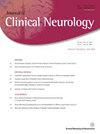巨细胞动脉炎的诊断、治疗和随访:一项回顾性多中心研究
IF 2.9
3区 医学
Q2 CLINICAL NEUROLOGY
引用次数: 0
摘要
背景和目的巨细胞动脉炎(GCA)是老年人最常见的血管炎类型,具有视力丧失和复发的高风险。由于其在亚洲人群中的罕见性,目前针对这些患者的临床干预措施并不为人所知。这项回顾性研究分析了 2009 年 2 月至 2022 年 11 月期间韩国六家大学医院的 GCA 患者病历。GCA 最初是根据 1990 年美国风湿病学会(ACR)标准诊断的,本研究根据 2022 年 ACR/欧洲风湿病学协会联盟标准选择病例。我们评估了伴有或不伴有动脉炎性前部缺血性视神经病变(AAION)的 GCA 患者的治疗方法、随访时间和结果(复发、缓解和药物不良反应)。7名患者(38.8%)患有AAION。所有患者最初都接受了泼尼松龙治疗,4 名患者(22.2%)在泼尼松龙减量期间接受了甲氨蝶呤和硫唑嘌呤的辅助治疗。在3.5个月的中位随访期间(四分位间范围:2.0-23.2个月),4名患者(22.2%)出现了与泼尼松龙相关的不良反应,2名患者(11.1%)复发,13名患者(72.3%)退出随访。9名患者(50.0%)病情缓解,其中4名患者(36.4%)病情持续缓解。泼尼松龙的不良反应很常见,约有十分之一的韩国 GCA 患者复发。因此,优化 GCA 治疗需要定期监测和长期随访。本文章由计算机程序翻译,如有差异,请以英文原文为准。
Diagnosis, Treatment, and Follow-Up of Giant-Cell Arteritis: A Retrospective Multicenter Study.
BACKGROUND AND PURPOSE
Giant-cell arteritis (GCA) is the most common type of vasculitis in the elderly and is associated with high risks of visual loss and recurrence. Owing to its rarity in Asian populations, the current clinical interventions for these patients are not well known. Here we aimed to characterize the current management status of patients with GCA using Korean multicenter data.
METHODS
This retrospective study analyzed medical records of patients with GCA at six Korean university hospitals from February 2009 to November 2022. GCA had originally been diagnosed based on the 1990 American College of Rheumatology (ACR) criteria, and cases were selected for inclusion in this study based on the 2022 ACR/European Alliance of Associations for Rheumatology criteria. We evaluated treatments, follow-up periods, and outcomes (relapse, remission, and adverse drug reactions) in patients with GCA with or without arteritic anterior ischemic optic neuropathy (AAION).
RESULTS
This study analyzed 18 patients with a median age of 75.5 years that included 12 females (66.7%). Seven patients (38.8%) had AAION. All patients initially received prednisolone treatment, while four (22.2%) underwent adjuvant treatment with methotrexate and azathioprine during prednisolone tapering. During the median follow-up of 3.5 months (interquartile range: 2.0-23.2 months), 4 patients (22.2%) had prednisolone-related adverse reactions, 2 (11.1%) relapsed, and 13 (72.3%) dropped out. Nine patients (50.0%) experienced remission, with this being sustained in four (36.4%).
CONCLUSIONS
This study observed high dropout rates and short follow-ups. Adverse effects of prednisolone were common, and relapses occurred in approximately one-tenth of Korean patients with GCA. Thus, optimizing GCA treatment necessitates regular monitoring and long-term follow-up.
求助全文
通过发布文献求助,成功后即可免费获取论文全文。
去求助
来源期刊

Journal of Clinical Neurology
医学-临床神经学
CiteScore
4.50
自引率
6.50%
发文量
0
审稿时长
>12 weeks
期刊介绍:
The JCN aims to publish the cutting-edge research from around the world. The JCN covers clinical and translational research for physicians and researchers in the field of neurology. Encompassing the entire neurological diseases, our main focus is on the common disorders including stroke, epilepsy, Parkinson''s disease, dementia, multiple sclerosis, headache, and peripheral neuropathy. Any authors affiliated with an accredited biomedical institution may submit manuscripts of original articles, review articles, and letters to the editor. The JCN will allow clinical neurologists to enrich their knowledge of patient management, education, and clinical or experimental research, and hence their professionalism.
 求助内容:
求助内容: 应助结果提醒方式:
应助结果提醒方式:


